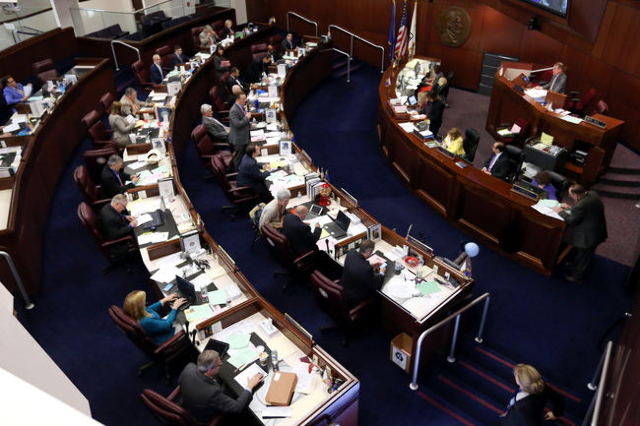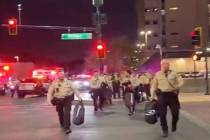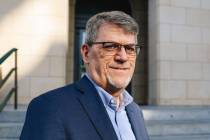Top stories of 2015: Legislature was historic one
A major tax package passed by the 2015 Legislature in the spring to fund Gov. Brian Sandoval's education reform plan and a rampage last week on the Strip that garnered international attention were among the major stories this year.
Other stories include legal sales of medical marijuana, the sentencing of the ringleader in a long-running homeowners association fraud scheme and the surprise announcement by Harry Reid, one of the most powerful figures in Congress, that he would not seek another term.
Here's the list of 10 major Metro stories for 2015.
1. GOP has its way in Nevada
It was a legislative session of historic and breathtaking proportions courtesy of Gov. Brian Sandoval, fresh off his huge second-term victory in the November 2014 election that saw a GOP juggernaut in Nevada.
Despite recalcitrant Assembly anti-tax Republicans, Sandoval pushed through a major tax package to fund his ambitious public education reform plan. Included was a first-ever commerce tax, which opponents are attempting to put before voters in November for possible repeal.
The $1.5 billion in continuing and new taxes won the two-thirds vote needed in both the Senate and Assembly to fund Sandoval's $7.3 billion two-year general fund budget and increase revenue to public schools. The budget includes more than a dozen new and expanded education initiatives from funding for gifted and talented students to helping struggling schools achieve.
School choice also got pushed through, with education savings accounts for parents who want to enroll their children in private schools. The program is being challenged in the courts.
In another major victory for Republicans, a bill requiring the breakup of the Clark County School District within the next three years was approved.
Sandoval, who faced more resistance from within his party than from Democrats for many of his proposals, achieved everything he wanted and more. Increased funding for autism services, a new medical school at UNLV and authority for ride-hailing companies such as Uber and Lyft to operate in Nevada all won approval from lawmakers.
Sandoval, who's popularity ratings are among the highest of all the nation's governors, ended the year on another high note with the announcement that electric car maker Faraday Future will build its $1 billion plant in Apex in Southern Nevada.
Sandoval's biggest challenge appears to be how he will top his 2015 achievements in the 2017 Legislature in what will be his last legislative session as governor.
— Sean Whaley
2. Reid decides to retire from Senate
WASHINGTON — U.S. Sen. Harry Reid announced in March that he would not run for re-election in 2016, signaling an end to a remarkable six-decade career in public office that saw the 76-year-old from rural Searchlight rise to become one of the most powerful political leaders in the nation.
Reid has served as the leader of the Senate Democratic Caucus since 2004 — serving as minority and majority leader as Democrats and Republicans have seesawed in power. Republicans currently hold the majority. As the caucus leader, Reid has enormous influence in shaping the legislative agenda — and ultimately the policies that end up in law.
The decision to retire was something that Reid said he and his wife, Landra, wrestled with for several months. Reid was blinded in his right eye and suffered at least three broken ribs in a freak home exercise accident New Year’s Day. The injury itself was not a factor in the decision but the down time during his recovery gave the couple a chance to think about his career and whether he wanted to face another re-election in 2016.
“We’ve got to be more concerned about the country, the Senate, the state of Nevada than about ourselves. And as a result of that, I’m not going to run for re-election,” Reid said in March.
Always a scrapper, Reid also suggested in March that he wanted to leave the Senate while he is still at the top of his game.
“I don’t want to wind up being a pinch hitter,” the lifelong baseball fan said discussing his decision on KNPR, the Las Vegas public radio station. “I want people to remember me for my first 34 years in Congress, not my last six.”
Before he walks into the sunset, Reid plans to work hard to see Democrats regain the Senate majority in the 2016 elections. He’s supporting former Nevada Attorney General Catherine Cortez Mastro in the Nevada race. Reid has laid the groundwork for Sen. Chuck Schumer, D-N.Y., to take hold of the caucus reins when he is gone.
Reid was first elected to the Nevada Assembly in 1968. His career in D.C. politics began in 1983, serving two terms in the House of Representatives before being elected to the Senate in 1986.
Reid’s retirement announcement came in a 3½-minute video, professionally produced with a stringed music soundtrack playing as photos from Reid’s career and some of him and his family were displayed under his spoken words. The video appeared to have been filmed at Reid’s Washington condo home at the Ritz-Carlton.
— Peter Urban
3. Judge nailed in investment scheme
Steven Jones spent two decades on the Clark County Family Court bench until his role in a decadelong investment scheme caught up with him.
The former judge was sentenced to 26 months in federal prison in February for his role in the scheme that defrauded several dozen people out of $2.9 million.
Jones, 58, pleaded guilty in September 2014 to one count of conspiracy to commit wire fraud and then resigned from the bench and gave up his law license. He admitted that he used his judicial office to further the scheme.
Jones, who often sparred with the Nevada Commission on Judicial Discipline during his tenure in office, and five others were indicted by a federal grand jury in October 2012 on charges of persuading people to lend them money for investment projects under the guise of quick repayment with high interest.
Following the indictment, Jones was suspended with pay and collected his $200,000 annual salary for all but three months until his resignation.
Today he is serving his time at a federal prison near Bakersfield, Calif., as federal prosecutors move to take away a public pension set to start paying him more than $10,400 a month in 2017.
— Jeff German
4. Driver plows into Strip crowd
A woman intentionally drove onto a crowded Strip sidewalk, leaving a visitor from Arizona dead and dozens of other people injured.
Just after 6:30 p.m. on Dec. 20, a woman heading north on Las Vegas Boulevard drove a 1996 Oldsmobile four-door sedan onto the sidewalk in front of the Planet Hollywood. The woman traveled down the sidewalk, said to have had more than 100 pedestrians on it, drove across a crosswalk at Paris Las Vegas and continued on the sidewalk until she exited near Bally's. The woman then drove about a mile on a flat tire to the Tuscany on the corner of Flamingo Road and Koval Lane.
Lakeisha Holloway, 24, of Oregon was arrested at the Tuscany in connection with the rampage. Her 3-year-old daughter, who was in the car with her, became a ward of the state until her family could be found.
Witness told police that the vehicle drove onto the sidewalk multiple times and had all four wheels on the sidewalk.
Jessica Valenzuela, 32, of Buckeye, Ariz., a wife and mother of three, was killed in the crash. Thirty-five other people were injured, three of whom had critical head injuries. The travelers came from Oregon, Colorado, Canada and Mexico, among other locales.
Holloway was charged Tuesday with one count each of murder with a deadly weapon, abuse and neglect and leaving the scene of an accident with injuries.
— Wesley Juhl
5. HOA scheme ringleader sentenced
Leon Benzer has been in federal prison the past two months, serving a 15½-year sentence as the mastermind of the massive scheme to take over and defraud homeowner associations.
Benzer, 48, a former construction company owner, pleaded guilty to felony conspiracy, fraud and tax charges in January, signaling the end of what federal prosecutors say was the largest public corruption case in Nevada.
Benzer and 42 co-conspirators either pleaded guilty or were convicted at trial in the long-running investigation launched by the FBI in November 2007.
Justice Department prosecutors say the wide-ranging conspiracy left a trail of ruin in its wake, including HOAs with substandard repair work, defrauded mortgage companies and homeowners with diminished property values.
Benzer and the late construction-defect lawyer Nancy Quon were the "principal architects" of the multimillion-dollar scheme, according to prosecutors.
The goal was to gain control of HOA boards through election rigging, obtain construction-defect litigation contracts for Quon and, ultimately, funnel repair work to Benzer's company, Silver Lining Construction.
Quon never was charged, but killed herself in March 2012 under the weight of the federal investigation. As many as a dozen HOAs were targeted by the Benzer organization.
— Jeff German
6. Uber rides in LV ... and at McCarran
Most people figured in November 2014, when representatives of Uber Nevada discontinued service in the state — which was deemed illegal at the time — that it would be back some day.
And it was, with a vengeance.
Lobbyists from companies such as Uber and Lyft swarmed the Nevada Legislature when it convened in early 2015 and convinced a majority of lawmakers that smartphone app-based ride-hailing transportation network companies should be allowed to operate in the state with regulations far different from those of traditional taxi and limousine companies.
High-powered taxi company lobbyists battled against the new companies throughout their campaign to no avail.
It took less than three months for regulations to be drafted and approved by the Nevada Transportation Authority.
After some brief confrontations in October and November with the Clark County Commission about requiring business licenses of drivers and for the company to provide the names of licensees, Uber and its smaller competitor, Lyft, were operating throughout the county including at McCarran International Airport.
Today, it is believed that there are thousands of Uber and Lyft drivers operating in Southern Nevada. The companies won’t disclose numbers and regulations don’t require it, even though there are ongoing questions about driver and passenger safety, insurance and how to address the growing problem of motorists posing as legal drivers or illegally accepting rides without using the app.
— Richard N. Velotta
7. Trouble for marijuana dispensaries
Seventeen years after Nevada voters first approved the use of marijuana for medical use, legal dispensaries opened last summer.
Next year could bring even bigger news: Voters will decide whether to make marijuana legal across the board.
The first half of 2015 was filled with frustration for patients and business owners.
The Nevada Legislature voted to allow medical dispensaries in 2013, along with growers and other related businesses. State health officials approved applications for those businesses in November 2014, and some expected to open in early 2015.
Instead, regulatory hurdles and business uncertainty delayed the launch for months. The first medical dispensary in Clark County, Euphoria Wellness, opened Aug. 24. A few weeks earlier, the state’s first shop opened in Sparks.
If the November ballot question is approved, “recreational” marijuana will be legal for anyone over age 21, with medical dispensaries still run and regulated separately.
Recreational marijuana will be taxed more than the medical kind, likely making it more expensive.
But state Sen. Tick Segerblom, one of the most prominent advocates for legalization, said the high prices shouldn’t be a problem in Las Vegas, land of the markup.
“Those tourists will be happy to pay whatever, because they’re coming here to have a good time,” he said. “Just like you go to a hotel and you pay $1,000 for a bottle of vodka for some strange reason.”
— Eric Hartley
8. Mother gunned down at home
The February shooting death of Las Vegas mother of four Tammy Meyers went global with early reports that she was the victim of senseless road rage. But as events unfolded, the truth proved even stranger — and provided a lesson in jumping to conclusions in the modern media age.
The 44-year-old mother of four died on Valentine's Day, two days after being gunned down in front of her northwest valley home.
Within a week of the shooting, police had arrested Erich Nowsch, the alleged gunman. A month later, authorities tracked down his alleged getaway driver, Derrick Andrews.
In the eye of a media maelstrom the Meyers family hired a lawyer and later a publisher.
Prosecutors said Andrews was behind the wheel of a silver 2000 Audi A6 from which Nowsch fired 24 shots, striking Meyers in the head Feb. 12 while she stood in the cul-de-sac in front of her home.
The shootout was initially attributed to "road rage," but a prosecutor said the deadly chain of events started after Meyers saw Andrews' car and mistakenly thought it was one that had earlier bumped hers.
Authorities said Nowsch fired a shot from a .45-caliber Colt handgun that struck Meyers in the head. Nowsch confessed to the killing during a police interrogation about a week after Meyers died. He told a homicide detective he thought he was shooting at people who had threatened him and his family.
By early September, prosecutors had extended an offer to Nowsch and Andrews for both to plead guilty in the slaying, but the deal was rejected.
Later that month, on the Meyers' 25th anniversary, public relations specialist Mark Fierro published "Road Rage in Las Vegas: The Senseless Murder of Tammy Meyers," a 71-page downloadable text of conversations with the Meyers family and friends.
Nowsch and Andrews are scheduled for trial in March.
— David Ferrara
9. Trouble inside Nevada prisons
CARSON CITY — Embattled Nevada Corrections Director Greg Cox resigned abruptly in September following months of high-profile conflicts at Nevada prisons.
His departure took root Nov. 12, 2014, inside the fortified walls and razor-wired perimeter of High Desert State Prison just north of Las Vegas, when one inmate was fatally shot and another was wounded by a correctional officer trainee.
The death of inmate Carlos Perez, 28, wasn’t revealed until four months later when the Las Vegas Review-Journal discovered the Clark County coroner’s office had ruled it a homicide. Another inmate, Andrew Arevalo, was wounded in the incident.
Both men were handcuffed behind their backs when they were shot in a shower hallway in a segregation unit known as "the hole." Separate lawsuits filed on behalf of Arevalo and the Perez family argue correction officers were responsible by allowing the inmates to be in the hallway at the same time against prison policy. One suit said officers created a “gladiator-style” scenario and refused to intervene before the officer trainee opened fire at the direction of other officers.
The Nevada attorney general’s office has been investigating the shooting since it received the case last spring and has said the probe could take a year.
That shooting was one of several in the last year at Nevada prisons, although no other fatalities were reported.
But they prompted Gov. Brian Sandoval to ask for a review of the department’s use of force by an outside agency. When the report was late despite assurances from Cox it would be available in September, the governor asked for his resignation.
Sandoval said he would conduct a nationwide search for a replacement. The position is still posted on the state’s job site.
— Sandra Chereb
10. Pipe dream flows to reality
The Southern Nevada Water Authority's new deep-water intake at Lake Mead is a pipe dream no more.
After seven years and $817 million, contractors finished work on the 3-mile tunnel underneath the bed of the nation's largest man-made reservoir.
The intake began delivering water to the Las Vegas Valley in late September, wrapping up the most complicated and expensive construction project ever undertaken by the Southern Nevada Water Authority.
Nothing about the job was easy.
First, general contractor Vegas Tunnel Constructors had to drill and blast a hole 600 feet deep near the shore of the lake. Then workers assembled a massive tunneling machine underground and used it chew through 3 miles of solid rock. The machine reached its destination late last year, when it punched through the side of 100-foot-tall intake structure that had been secured to the bottom of the lake in 2012 with 12,000 cubic yards of special concrete pumped into place from a flotilla of cement trucks on barges.
On Sept. 23, the contractor removed the cap from the finished tunnel.
Authority officials consider the project crucial drought insurance for a community that draws 90 percent of its drinking water from Lake Mead.
The third intake — coupled with a $650 pumping station due to be built over the next five years — will keep water flowing to the valley even if the lake shrinks low enough to dry out the community's two existing straws and prevent Hoover Dam from releasing water downstream.
Work on the pump station is underway.
— Henry Brean

















